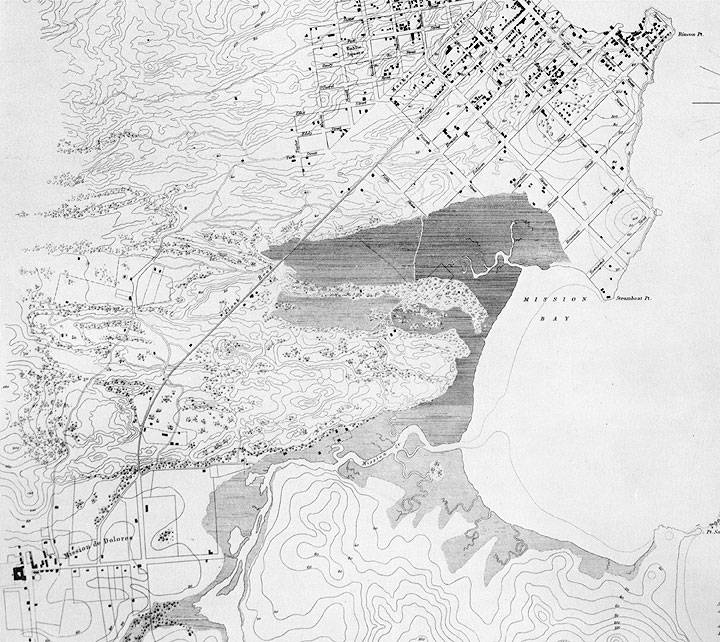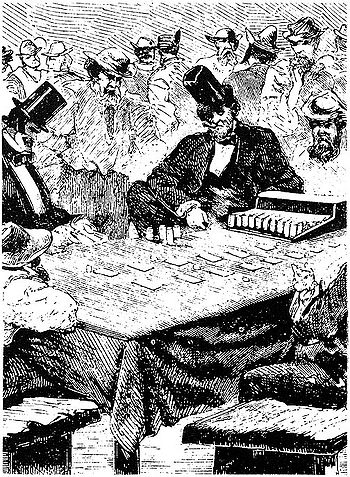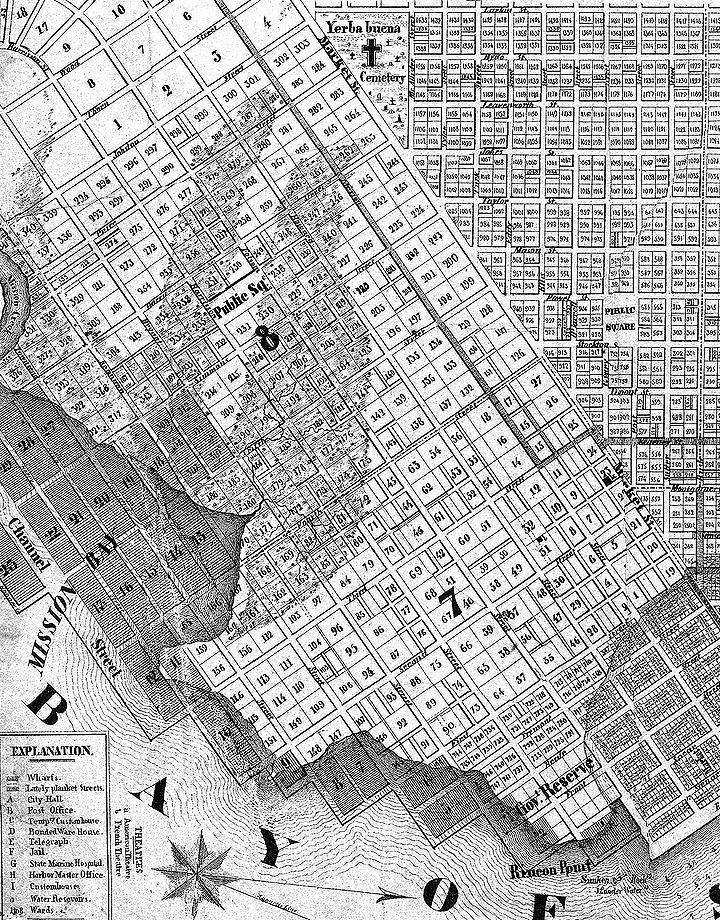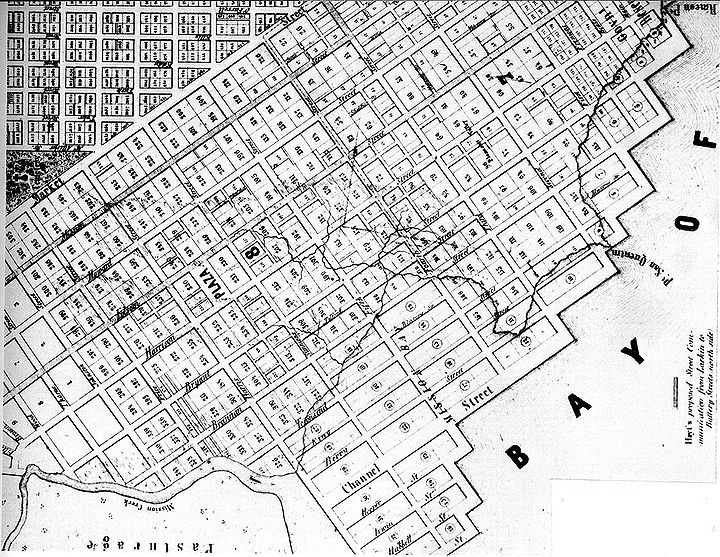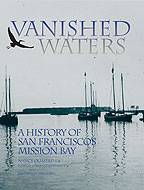The Golden Era, 1848-1853
Historical Essay
by Nancy J. Olmsted
At the height of the Gold Rush, in February 1852, the U.S. Coast Survey published a map of every house, warehouse, wharf, street, fence, windmill, sandhill, mudflat, creek and line of vegetation in San Francisco and its environs (see map, below). The astonishing degree of development above Market Street, around Yerba Buena Cove, is an enormous contrast to the nearly deserted marshlands near the Mission. Market Street extended out past the line of Fremont Street in the bay. Commercial Street, past Davis Street, became Central Wharf (or as it was more commonly called, “Long Wharf”) with an angle at its end to avoid running into the Market Street Wharf. Pacific and Broadway wharves headed out from Front Street to meet the ships of the world.
Mission Bay, February 1852—U.S. Coast Survey Map. At the time of this topographical survey, sand hills block Market Street between Second and Third and the core of the city’s development is clustered around Yerba Buena Cove, north of Market. The slender connection of the Mission Plank Road makes it way across the extensive salt marsh, starting at about the line of Sixth Street. Fourth Street ends just past Folsom at the edge of this same marsh, which is cut through by a meander of a tidal slough off Mission Bay. Steamboat Point has only a scatter of sheds to mark a place already teeming with shipbuilding on a large scale.
The isolated scatter of small structures near Mission Bay avoided the mudflats, seeking higher ground, as shown by land contours and clusters of willows and scrub oak. A slightly later version of this map, published in 1853, added hydrographic information showing Mission Bay waters to have one-foot readings until they reached an outwardly curving line from Steamboat Point on the north, to Pt. San Quentin (Potrero Point) on the south.
Mission Bay’s slender connection to Gold Rush San Francisco is the Mission Plank Road (today’s Mission Street), which opened as a toll road in 1851. Its three-and-a-quarter-mile length ran into trouble for the contractors where it crossed the line of Seventh Street (shown but not named on the 1852 map above). Here they had projected a bridge built on pilings, “but that plan had to be abandoned, to the astonishment and dismay of the contractor; the first pile, forty feet long, at the first blow of the pile driver sank out of sight, indicating that there was no bottom within forty feet to support a bridge. One pile having disappeared, the contractor hoisted another immediately over the first and in two blows drove the second down beyond the reach of the hammer. . . there was no foundation within eighty feet. . . pilings were abandoned, and cribs of logs were laid upon the turf so as to get a wider basis than offered by piles. The bridge made thus always shook when crossed by heavy teams and gradually settled till it was in the middle about five feet below the original level . . . the cost of the road was ninety-six thousand dollars, about thirty thousand dollars per mile. . . the plank road company obtained another franchise for a road on Folsom Street. . . in 1854 a high tide overflowed the [Folsom] road between Fourth and Fifth and floated off the planking. ”34
J.S. Hittell, writing in 1878, goes on to observe that, although these marshy areas were called swamps, “they seem to have been for part of their area at least, subterranean lakes, from forty to eighty feet deep, covered by a crust of peat moss eight or ten feet thick. . . . When the streets were first made, the weight of the sand pressed the peat down, so that the water stood where the surface was dry before. . . . More than once a contractor had put on enough sand to raise the street to the official grade, and gave notice to the city engineer to inspect the work, but in the lapse of a day between notice and inspection the sand had sunk down six or eight feet. . . heavy sand crowded under the light peat at the sides of the street and lifted it up eight or ten feet above its original level, in muddy ridges full of hideous cracks. . . it was also pushed sidewise so that houses and fences built upon it were carried away from their original position and tilted up at singular angles. . . .”35
The toll road to the Mission probably would have gone out Market Street, but there was an 80-foot sand hill between Second and Third streets. It wasn’t long before the leveling of the city’s many sand hills met the urgent need for filling in the water lots. The giant steam shovel, or “steam paddy” (it was said to do the work of twenty Irish laborers at a single stroke), started to level sand hills in 1852. It could be heard night and day, shoveling sand into open boxcars with its railroad engine carrying the carloads on temporary tracks to dump in Yerba Buena Cove. Later, in the period from 1859 to 1873, the steam paddy took south-of-Market sand to fill Mission Bay.36
One of the most significant features on this first scientific map of Mission Bay is Steamboat Point, which marks the northern boundary of the bay. In 1852, Townsend Street fronted on the bay between Second and Third, with a hundred foot sand hill close to Second Street. The geography of this important point of land was to influence the entire development of Mission Bay. Steamboat Point was high and dry land, edged by a relatively narrow shelf of shallow water (2-3 feet) meeting deeper water (24-30 feet) very close in. For this reason H.B. Tichenor built his marine railway from Steamboat Point out into the bay to haul up ships for repair. Tichenor bought his water lot in June 1851, at one of the Peter Smith sales, and said in his recollection to H.H. Bancroft that he paid $2,700 for this lot. By 1868 the Central Pacific was to pay $250,000 for this same point of land. Such was the importance of this location in the city’s history.
San Franciscans gambling in 1851. J.D. Borthwick wrote, “There were a dozen or more tables each with a compact crowd of eager betters around it, and the whole room so filled with men that elbowing one’s way between tables was a matter of difficulty. The atmosphere was hazy with tobacco smoke, and strongly impregnanted with the fumes of brandy. . . Nothing was heard but the slight hum of voices, and the constant clinking of money.”
Image: Nancy Olmsted
A Sense of the Times
“And everybody made money, and was suddenly growing rich. . . .” So wrote the chroniclers of “The Annals of San Francisco,” in 1854, trying to explain the extraordinary events they had observed and written about as publishers and editors of the city’s early prestigious newspapers.37 To understand the nature of the speculative schemes for Mission Bay real estate, it is first necessary to comprehend and appreciate the all-encompassing mood of San Francisco’s population—a body of mostly young men set out on the adventure of their lives. The city had 459 inhabitants in the latter part of June 1847; by the close of 1849 there were somewhere between 25,000 and 30,000 people and “there was no such thing as a home to be found. Both dwellings and places of business were either common canvas tents, or small rough board shanties. . . only gambling saloons, hotels and restaurants and a few public buildings and stores had any pretentions to size, comfort, or elegance. . . [T]he unplanked, ungraded, unformed streets (at one time moving heaps of dry sand and dust; at another, miry abysses, whose treacherous depths sucked in horse and dray, and occasionally man himself) were crowded with human beings from every corner of the universe and of every tongue—all excited and busy, plotting, speaking, working, buying and selling town lots, and beach and water lots, shiploads of every kind of assorted merchandise, the ships themselves, if they could—gold dust weighed in the hundredweights, ranches square leagues in extent with their thousands of cattle-allotments in hundreds of contemplated towns, already prettily designed and laid out on paper—and in short, speculating and gambling in every branch of modern commerce. . . . The loud voices of the eager seller and as-eager buyer—the laugh of reckless joy—the bold accents of successful speculation. . . . Fortunes were won and lost, upon that green cloth, in a twinkling of an eye. . . . The heated brain was never allowed to cool. ”38
Everyone ate in hotels, restaurants or boarding houses, as “time was too precious for anyone to stay indoors and cook his victuals.” Tall tales, rumors and facts were all mixed together, in a continuous noisy conversation. Having no homes, where else could people go but to the bright lights and music of the gambling houses—saloons where the sight of bags of gold dust exchanging hands on the turn of a card was itself intoxicating. The peculiar fever-pitch of the times was heightened by the visible abundance of gold, “tables were piled with heaps of gold and silver coin, with bags of gold dust and lumps of pure metal to tempt the gazer. . . . Men had come to California for gold; and, by hook or crook, gold they would have. Therefore they staked and lost and staked and won—till in the end they were rich indeed, or penniless.”39
1852 Map of San Francisco, Compiled from latest Surveys & containing all late extensions & Division of Wards. Published By Britton & Rey, San Francisco CA. Letter sheet map showing the “Lately planket (sic) Streets” and the original shoreline.
The almost universal prediction was that San Francisco was destined to become a great world seaport, rivaling London and New York. The free flow of capital looked for investment. The fever of real estate speculation was fanned by the knowledge of local rents. Bayard Taylor, correspondent from the New York Tribune, wrote: “It may be interesting to give here a few instances of the enormous and unnatural value put upon property. . . . The Parker House rented for $110,000 yearly, at least $60,000 of which was paid by gamblers, who held nearly all of the second story. Adjoining it on the right was a canvas tent, fifteen by twenty-five feet, called “Eldorado” and occupied likewise by gamblers, which brought $40,000. On the opposite side of the Plaza [Portsmouth] a building called the ‘Miner’s Bank,’ used by Wright & Co., brokers. . . was held at a rent of $75,000. A mercantile house paid $40,000 rent for a one-story building of twenty-feet front. . . . A friend of mine who wished to find a place for a law office was shown a cellar in the earth, about twelve feet square and six feet deep, which he could have for $250 a month. . . . ”40
In addition to these enormous rents, the interest rates on borrowed money were running from eight to fifteen percent per month-paid in advance. “Real estate, that but a few years before was of little more worth than an old song, now brought amazing prices. From twelve dollars for fifty-vara lots [a reference to the sales of August 1847] prices generally rose to hundreds, thousands and tens of thousands of dollars, so that large holders of such properties became sudden millionaires. ”41
Plans for the Land
As the Coast Survey Map shows the actual level of development in San Francisco and Mission Bay, so the 1853 map by Alex Zakreski (below) delineates the plans for the land—a look at the future.
Among the planned extensions and improvements are the water lots from Brannan Street south, past Channel Street, around Steamboat Point (mislabeled Pt. San Quentin by Zakreski, who took the then-current name from more southern Potrero Point) up to Rincon Point. Mission Creek and Channel Street (in Mission Bay) mark the southern boundary of the city; the presidio defines the northern limits as “Government Reserve.” The grid pattern of streets, laid out in O’Farrell’s 1847 survey, extends right out into the shallow coves of the bay, defining the boundaries of water lots.
Already the precedent had been set with Kearny’s “Great Sale of Beach and Water Lots” in Yerba Buena Cove in 1847. As Congress had transferred “swamplands and tidelands to the state of Arkansas and other states” in an act in 1851, these rectangles of land under water represented State of California lands, now conveyed by an act of the state legislature to San Francisco—with some provisos. The act required that the city pay the state 25 percent of the value of the water lots sold, and also gave the city the land for only 99 years, a long-term lease that enabled the state to sell water lot “reversionary rights” a second time around. As a result we find the same land being auctioned first by the city and some months later by the state, resulting in future confusion of title. Buyers of “reversionary rights” (property their heirs would not own until 1950-51) could use these titles for speculative purposes.
The city of San Francisco plunged into debt making street improvements of heroic proportions, paying city contractors in city scrip (promissory notes) for which water lots now became collateral. City scrip bore the relatively modest interest rate of three percent a month-still, that amounted to 36 percent a year, causing modest debts to bloom into substantial amounts. One of the city’s contractors was Dr. Peter Smith.
The plan for San Francisco in 1853. Zakreski’s map is entitled “The only corect & fully complete Map of San Francisco, Compiled from the Original Map & recent Surveys, Containing all the latest extensions & improvements, New streets, alleys, places, wharfs & Divisions of Wards. Respectfully dedicated to the City Authorities, 1853.”
Map: California Historical Society
The Infamous Dr. Peter Smith
Dr. Peter Smith is one of the elusive characters of the Gold Rush who appears in San Francisco in 1850 and is gone by 1854, never to be mentioned again except in newspaper accounts and in the ensuing legal snarls over land titles, where his name is always coupled with “infamous.” It all started fairly innocently.
In 1850, Dr. Peter Smith contracted with San Francisco to care for the sick among the city’s indigent population at the rate of $4 per day per patient, to be paid in city scrip at the customary 3 percent interest per month. In 1851 Dr. Smith demanded that his city scrip be exchanged for coin; he went to court and obtained a judgment against the city for $19,238 (out of an eventual total of $64,431). Under a law that allowed creditors to sell property belonging to their debtors, Dr. Smith coerced the city fathers (now called “The Commission for the Funded Debt”) into selling available San Francisco real estate, mostly water lots, to payoff his claims. Meanwhile the state legislature passed an enabling bill so that San Francisco could convert its scrip into bonds bearing 10 percent per annum. Smith was not agreeable to exchanging his scrip for bonds, he wanted cash.
The first great Peter Smith sale took place on June 14, 1851, as Sheriff Jack Hayes auctioned 103 water lots, seven blocks of beachfront property and seven additional lots belonging to the city. That same day, a notice signed by all the members of the Commission for the Funded Debt appeared in the newspapers: “. . . the public is hereby notified that the city has no legal title to said lots. . . . Everyone will readily perceive that a purchase made at the Sheriff’s sale will convey no title. . . . ”42
It is hardly surprising that, although the lots were all sold, the prices were “not a twentieth or even a fiftieth part of their value.” As not enough money was raised to pay Smith’s debt, a second auction was held on July 8. Still the cloud of “no title conveyed” hung over the properties, requiring a third, a fourth and, on January 30, 1852, a great final sale in which 2,000 acres of city land were disposed of.
By now everyone realized that, whether the city fathers were deliberately depressing the prices of the water lots so they could buy up the land for themselves and friends, or whether they had simply bungled one attempt after another to make good their debt to Dr. Smith, the fact was that they had sold off “the patrimony of the city” for very little return. None of this was accomplished quietly. The newspapers of the city took sides, attacking or defending State Senator David Broderick, who fathered many of the water lot bills in Sacramento and at the same time bought bargain lots in San Francisco. In time, the matter of whether the buyers at the Peter Smith sales held clear title to their land went to the California Supreme Court where the surprising unanimous decision was reached that the titles were valid. One of the judges was the same man who earlier, as learned counsel to the Commission for the Funded Debt, had advised that body to publish his opposite opinion. Dr. Smith took his settlement and title to 75 of the lots and left town. Later in a series of decisions, the Supreme Court of the United States set aside the California court’s action.
One outcome of the Peter Smith sales was a spate of investment and speculation in South Beach and Mission Bay water lots. Two men who profited much were “Judge” John McHenry and William Cornell Jewett.

